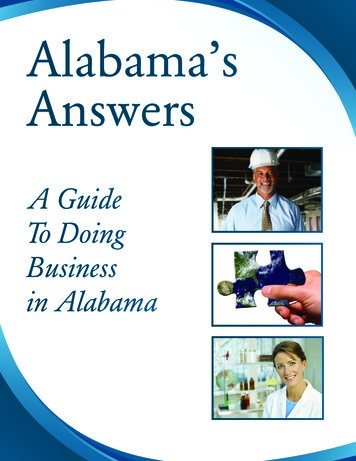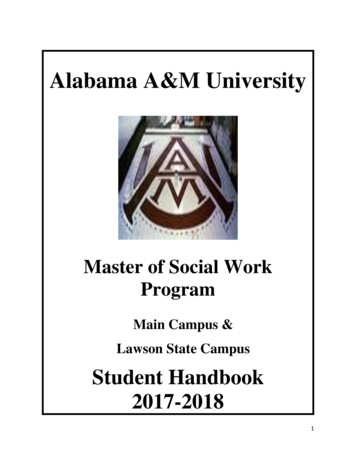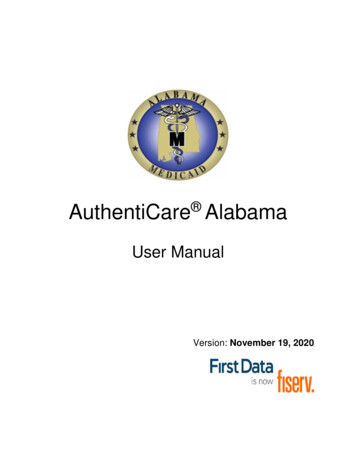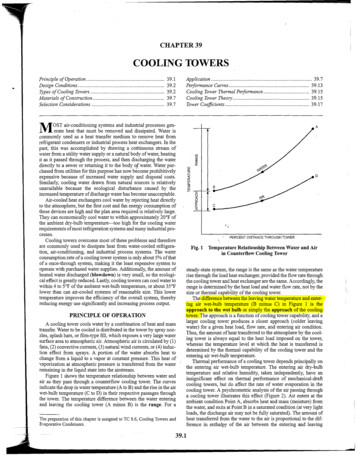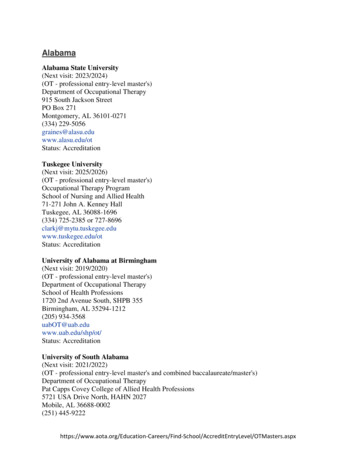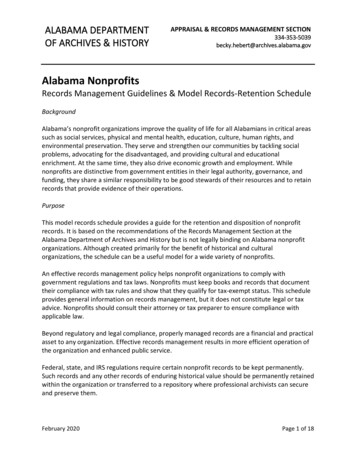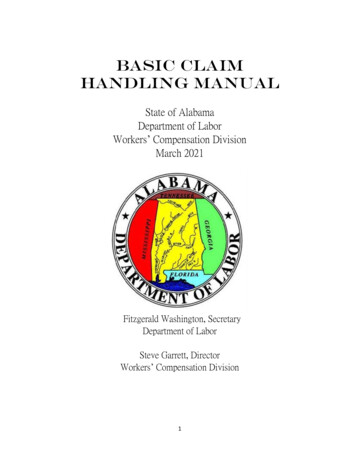
Transcription
Basic ClaimHandling ManualState of AlabamaDepartment of LaborWorkers’ Compensation DivisionMarch 2021Fitzgerald Washington, SecretaryDepartment of LaborSteve Garrett, DirectorWorkers’ Compensation Division1
DISCLAIMERThis booklet is not intended to be a comprehensive explanation of the AlabamaWorkers’ Compensation Law. We have, however, attempted to point out andexplain some of the more common problems and questions that arise inhandling Alabama Workers’ Compensation claims.This booklet is also not intended to give legal advice and is subject to changewithout notice. Legal advice, legal opinions, or legal representations shouldbe solicited from a competent attorney licensed to practice law in yourparticular jurisdiction.This booklet is the interpretation of the Alabama Worker’s Compensation Lawby the staff of the Alabama Workers’ Compensation Division and is intendedfor informational purposes only.Please feel free to reproduce.2
INTRODUCTIONThe Alabama Legislature passed the first Workers’ Compensation Law in1919, effective January 1, 1920. There have been many legislative changesand court decisions since then, but basically, the philosophy of the original Acthas been retained.The purpose of the Workers’ Compensation Law is to provide prompt andnecessary medical treatment, and wage replacement for workers who areinjured or killed from an accident arising out of and in the course of theiremployment.Workers’ Compensation was designed as a substitute for common-law tortactions for personal injuries between master and servant.The Alabama Workers’ Compensation Act is found at §25-5-1, et. Seq. Codeof Alabama, as amended, 1975.3
TABLE OF CONTENTSI. Definitions .5II. Compensation 7Waiting Period .7Computation and Filing .8Temporary Total Disability .8Temporary Partial Disability .9Permanent Partial Disability .10Permanent Total Disability .11Death 12Death Following Disability .12Penalty for Overdue Compensation 12Vocational Disability .13III. Medical .14IV. Disputed Medical Claims .14Employee Refuses Medical .14Fee Schedule .15Medical Subrogation .15Mileage Cost .16Physician .17Vocational Rehabilitation .17V. Miscellaneous .18Fraud .18Ombudsman Program . .18Compensation Rates for Alabama .20Quick Reference Sheet for New Adjusters.214
I.DEFINITIONS §25-5-11.Compensation: The money benefits to be paid because of injury ordeath. “Compensation” does not include medical.2. Child or Children: Children entitled by law to inherit as children of thedeceased.3. Dependent Child or Orphan: An unmarried child under the age of 18years or one over that age who is physically or mentally incapacitated.4. Employer: Every person who employs another to perform a service for hireand pays wages directly to that person.5. Employee: Every person in the service of another under any contract ofhire, express or implied, oral or written, including aliens and minors, who arelegally permitted to work under the laws of Alabama.6. Wages/Average Weekly Earnings:The average weekly wage is basedon the employee’s earnings which are subject to federal income taxation andreportable on the Federal W-2 tax form.7. Accident: An unexpected or unforeseen event, happening suddenly andviolently.8. Injuries by an Accident Arising Out of and in the Course of theEmployment: Workers’ Compensation does not cover workers except whileengaged in or about the premises where their services are being performed orwhere their service requires their presence as a part of the service at the time ofthe accident and during the hour of service as workers.9. Injury: Injury by accident arising out of and in the course of theemployment, and not a disease in any form, except an occupational disease orwhen a disease results naturally and unavoidably from the accident. Injuryshall include physical injury covered either by carpal tunnel syndrome or othercumulative trauma disorder and breakage or damage to eyeglasses, hearingaids, dentures, or other prosthetic devices when injury to them is caused by anon-the-job injury to the body. Injury does not include a mental disorder ormental injury unless caused by some physical injury to the body.10. Singular and Plural: Whenever the singular is used, the plural shall beincluded.11. Gender: When the masculine gender is used, the feminine and neuter shallbe included.5
12. Loss of Hand or Foot: Amputation between the elbow and wrist shall beconsidered the equivalent to the loss of a hand. The amputation between theknee and ankle shall be considered the equivalent of the loss of a foot.13. Provider:Person or entity providing treatment, service or equipment,or facilities at which the employee receives treatment.14. Medical: All services, treatment or equipment provided by a provider.15. Prevailing: When cost for medical treatment exceeds the maximum ratefor reimbursement, the “prevailing” rate applies.16. Participating and Nonparticipating Hospital: Hospitals that have anegotiated rate of reimbursement are participating hospitals and those that havenot negotiated a rate of reimbursement are nonparticipating hospitals.17. Hospital: A hospital, ambulatory surgical center, outpatient rehabilitationcenter licensed by the State of Alabama and diagnostic facilities accredited bythe Commission on Accreditation of Rehabilitation Facilities.18. The Court: The circuit court that would have jurisdiction in an ordinarycivil action and “the judge” means a judge of that Court.19. Utilization Review: A determination of medical necessity. Not mandatory.20. Bill Screening: The evaluation and adjudication of provider bills forappropriateness of reimbursement relative to medical necessity and prevailingrates of reimbursements, duplicate charges, unbundling of charges, etc. Notmandatory.21. Adjudication: Review of claims to apply prevailing rules that adjustreimbursements for work required when multiple procedures are performed atthe same time, when assistant surgeons are present, to eliminate duplicatebilling and to adjust for the most commonly occurring method adopted for totalreimbursement.22. Ombudsman: An individual who helps injured or disabled employees,persons claiming death benefits, employers and other persons in protectingtheir rights and obtaining information available under the Workers’Compensation Law.6
II. COMPENSATIONWAITING PERIOD §25-5-59:There is a three (3) day waiting period in the State of Alabama.Compensation is owed beginning on the fourth (4th) day of disability. Whenthe injured employee is out twenty-one (21) days, the three (3) day waitingperiod is added to the first compensation payment due after the twenty-one(21) days. If the employee sustains an injury, and it is obvious loss time willexceed twenty-one (21) days, the three (3) day waiting period may be waivedand compensation begun on the first day of disability.To compute the three-day waiting period when the employee is paid in full fordate of injury:Date/Injury:07/05/00Date/Disability: 07/06/00Waiting Period: 07/06, 07, 08/00Begin Compensation: 07/09/00To compute the three-day waiting period when the employee is not paid in fullfor date of injury:Date/Injury: 07/05/00Date/Disability: 07/05/00Waiting Period: 07/05, 06, 07/00Begin Compensation: 07/08/00If the employee is injured on 07/05/00 and continues to work for a period oftime (thru 07/14/00), the date of disability will be 07/15/00.Date/Injury: 07/05/00Date/Disability: 07/15/00Waiting Period: 07/15, 16, 17/00Begin Compensation: 07/18/00The WC Form 2, Employer’s First Report of Injury,http://labor.alabama.gov/docs/forms/wc froi new with different margins.pdf (printable document)http://labor.alabama.gov/docs/forms/wc alabama froi.doc (Fill-indocument) should be filed within fifteen (15) days after the date of injury ordate of notification if days lost from work exceed three(3) days.7
COMPUTATION AND FILINGTEMPORARY TOTAL DISABILITY §25-5-57:Payments of compensation are to be made at the intervals that the earningswere payable, as nearly as possible, unless the parties otherwise agree.Temporary total disability (TTD) begins with the first day the injuredemployee is not paid in full. Temporary total disability is computed bymultiplying 66 2/3% (.6667) times the average weekly wage (AWW). If 66 2/3% of the average weekly wage is more than the maximumcompensation rate, drop back to the maximum compensation rate in effect attime of injury.NOTE: Example is based on a July 5, 2000 injury date and AWW of 900.00:AWW: 900.0066 2/3 %x.6667 600.00The Maximum Comp Rate of 531.00 should be paid effective 07/01/00. If 66 2/3 % of the average weekly wage is less than the minimumcompensation rate in effect at time of injury, then the minimum compensationrate is applicable.NOTE: Example is based on a July 5, 2000 injury date and AWW of 180.00:AWW 180.0066 2/3%x .6667 120.00The Minimum Comp Rate of 146 should be paid effective 07/01/00. If the average weekly wage is less than the minimum in effect at the time ofinjury, then 100% of the average weekly wage is applicable.NOTE: Example is based on a July 5, 2000 injury date and AWW of 140.00:AWW 140The Comp Rate of 140 should be paid.File a WC Form 3 http://labor.alabama.gov/docs/forms/wc supp report.pdfto begin TTD and a WC Form 4http://labor.alabama.gov/docs/forms/wc claim summ form.pdf to suspendTTD or the Combination Supplementary & Claim Summary Formhttp://labor.alabama.gov/docs/forms/wc combination%20 rev%201-16-02 1.pdf8
TEMPORARY PARTIAL DISABILITY §25-5-57:Temporary Partial Disability (TPD) is paid when an employee returns to work,with restrictions, to light duty or part-time. Temporary Partial Disability ispaid at 66 2/3% of the difference in the employee’s earnings at the time ofinjury and the earnings in his restricted capacity. This compensation is paidduring the period of disability but not beyond 300 weeks, subject to themaximum only in effect on date of injury.AWW on Date/Accident 900.00AWW on Return/Work - 450.00Difference 450.0066 2/3%x .6667TPD Compensation Due 300.02A WC Form 3, Section A is filed when temporary partial disability is begunand a WC Form 4 is filed when payments are suspended.When temporary partial disability is paid and there has been no period oftemporary total disability, the three (3) day waiting period is figured the sameas temporary total disability, subject to the maximum compensation rate.Exception: If the employee is working part-days, then the part-day isconsidered as one day of the waiting period.9
PERMANENT PARTIAL DISABILITY §25-5-57:Permanent partial disability (PPD), scheduled or unscheduled injury, is subjectto a maximum of 220.00 per week. The following example is based on ascheduled injury using a 10% permanent partial disability rating to the leg:Number of weeks from schedule for loss of leg10% PPD ratingWeeks due for PPDMaximum PPD ratePermanent Partial Disability Due200 weeksx .1020x 220.00 4,400.00The following examples are based on an unscheduled injury using a 10%permanent partial disability rating to the body as a whole:10% PPD rating to body/wholeLess number of weeks of TTD paidWeeks remaining to be paidStart with the AWW10% PPD rating66 2/3%PPD weekly compensation rateMultiply weeks remainingPermanent Partial Disability Due300 weeks- 30270 weeks 900.00x.10 90.00x .6667 60.00X 270 weeks 16,200.00Permanent partial disability can be paid either weekly or in a lump sum. If alump sum is agreed upon by both parties, remember that only future paymentscan be discounted.A WC Form 3, Supplementary Report, Section A and a WC Form 4,Summary Report should be filed for each period of permanent partialdisability.10
PERMANENT TOTAL DISABILITY §25-5-57:Permanent Total Disability (PTD) does not mean total helplessness.Permanent Total benefits have no limitations on the amount or length of timeof payment. If an injured employee is determined to be a permanent total,whereby, he is unable to obtain suitable or gainful employment as a result ofthe injury, he is entitled to PTD benefits for the remainder of his life, or untilhe is gainfully employed through vocational rehabilitation.Permanent Total Disability means the inability to:1.2.3.4.Perform one’s tradeObtain other reasonable gainful employmentPerform gainful employment with reasonable accommodations, orBe retrained for reasonably gainful employment.Permanent Total Disability is computed at 66 2/3 % of the average weeklywage, not to exceed the maximum in effect at the time of injury. Benefits arepaid for duration of disability (lifetime benefits) but can be altered byvocational rehabilitation.A WC Form 3, Supplementary Report, Section A and a WC Form 4,Summary Report, should be filed.11
DEATH§25-5-60:Where death results proximately from the accident within three years,compensation is payable to dependents entitled thereto without administrationor to a guardian or other person as the Court may direct, for the use and benefitof the person entitled thereto.Death benefits are based on the employee’s average earnings at the time of theaccident, subject to the maximum and minimum in effect at the time ofaccident. If the employee leaves one dependent, the dependent is entitled to50% of the employee’s average weekly wage, subject to maximum andminimum. If the employee leaves two or more dependents, the dependentsare entitled to 66 2/3% of the employee’s average weekly wage, subject tomaximum and minimum in effect at time of injury resulting in death.Precedence of dependents is listed in §25-5-62 and the amount/percentage isdetermined by the Court. Death benefits are payable for 500 weeks, subjectto limitations such as remarriage of the widow, etc., as defined in §25-5-66.DEATH FOLLOWING DISABILITYIf death follows a period of disability, the period of disability will be deductedfrom the 500-week period due the dependent(s). If an employee dies ofcauses not related to the injury, while receiving permanent partialdisability/permanent total disability, the remaining compensation due ispayable to his dependents if the degree of disability has been agreed upon bythe parties or if a court has determined the degree of disability.Compensation payable to dependents shall not exceed the amount due, had thedeath resulted from the injury. In all death claims where the cause of death isobscure or is disputed, any interested party may require an autopsy, the cost ofwhich is to be borne by the party demanding the autopsy. The 1992Amendment provided for a 7,500.00 death benefit for an employee who hasno dependents at the time of his death. Burial expenses up to 6,500.00 arepayable to all employees whose death is the result of an accident or illnessarising out of and in the scope of employment.As with other types of disability, a WC Form 3, Supplementary Report,Section A, reporting the initiation of payment and a WC Form 4, SummaryReport, showing the suspension of payments, should be filed.PENALTY FOR OVERDUE COMPENSATION PAYMENTSIf any installment of compensation payable is not paid without good causewithin 30 days after it becomes due, there shall be added to the unpaidinstallment an amount equal to 15% thereof, which shall be paid in addition tothe installment amount.12
VOCATIONAL DISABILITYIf an injured worker returns to work at a wage equal to or greater than his preinjury wage, and if he has sustained a permanent partial disability, he is notentitled to any vocational disability. The permanent partial disability is paidon the physical impairment rating only. However, if he loses his job throughno fault of his own within 300 weeks from the date of injury, or if returned to ajob paying less than his pre-injury wage, he may petition for his vocationaldisability.If the injured worker returns to work and the wage is less than his pre-injurywage, he is entitled to a vocational disability and is not paid permanent partialdisability based on a physical impairment rating.13
III. MEDICAL §25-5-77Under Alabama Workers’ Compensation Law, an employee who sustains acompensable injury by accident or occupational disease, is entitled to lifetimemedical benefits for the work-related injury. Medical treatment must bemedically necessary and appropriate for the treatment of the injury or illnessand must be provided by an authorized physician. Medical services providedby an unauthorized physician are not covered and will not be reimbursed.DISPUTED MEDICAL CLAIMSIf a claim for medical services rendered is disputed, notify the provider thatthe claim is in dispute and advise them of the nature of the dispute. This iscrucial because medical providers can file a formal complaint with theCommissioner of Labor. §25-5-77(i) states, “Any party, including a healthcare provider, is entitled to a review by an ombudsman of medical servicesprovided or for which authorization of payment is sought if any party or healthcare provider has any of the following:1. Been denied payment or had the charge reduced for medical servicesrendered.2. Been denied authorization for payment of services requested or performedwhen authorization is required.3. Been ordered by the Commissioner to refund payments received for theprovision of medical services.4. A party to a medical dispute that remains unresolved after a review ofmedical services as provided by this section may petition the court for relief.5. In any review under this subsection of medical services provided by aphysician, any party to a dispute may request the ombudsman consult with anindependent medical expert from a list of at least three names provided by theWorkers’ compensation Medical Services Board in a medical specialtyappropriate to the issues raised in the dispute and shall secure a written opinionfrom the independent medical expert. In rendering a decision orrecommendation, the ombudsman shall give full consideration to the opinionof the independent medical expert but shall not be bound by that opinion.EMPLOYEE REFUSAL OF MEDICAL SERVICESIf an injured employee refuses to comply with reasonable request forexamination, refuses to accept physical rehabilitation which the employerelects to furnish, or refuses to comply with the treatment plan or regimenordered by the treating physician, the employee’s right to compensation shallbe suspended and no compensation shall be payable for the period of therefusal or non-compliance.14
FEE SCHEDULEThe Workers’ Compensation Fee Schedule limits an employer’s liability to thefees listed in the schedule. Employers can negotiate with providers for lowerrates than those in the fee schedule.MEDICAL SUBROGATIONAn employer shall be allowed to subrogate medical and vocational benefitexpenses recovered in a third-party suit.15
MILEAGE COSTSMileage costs to and from medical and rehabilitation providers shall be paid atthe rate as provided by law for official state travel. Effective January 1, 2021,the rate for mileage is .56 cents per mile - the rate paid to state employees subject to change. Mileage rates are:August 1, 1992October 1, 1999January 1, 2000January 1, 2001January 1, 2002January 1, 2003January 1, 2004January 1, 2005September 1, 2005January 1, 2006January 1, 2007January 1, 2008July 1, 2008January 1, 2009January 1, 2010January 1, 2011July 1, 2011January 1, 2013January 1, 2014January 1, 2015January 1, 2016January 1, 2017January 1, 2018January 1, 2019January 1, 2020January 1, 2021 0.25 0.31 0.325 0.345 0.365 0.36 0.375 0.405 0.485 0.445 0.485 0.505 0.585 0.55 0.50 0.51 0.555 0.565 0.56 0.575 0. 54 0.535 0.545 0.58 0.575 0.5616
PHYSICIANThe term “physician” shall include medical doctor, doctor of osteopathy andchiropractor.VOCATIONAL REHABILITATIONIf the employer so elects, the employee shall submit to and undergo vocationalrehabilitation at the employer’s expense. I
5 I. DEFINITIONS §25-5-1 1. Compensation: The money benefits to be paid because of injury or death. “Compensation” does not include medical. 2. Child or Children: Children entitled by law to inherit as children of the deceased. 3. Dependent Child or Orphan: An unmarried child under the age of 18 years or one o
